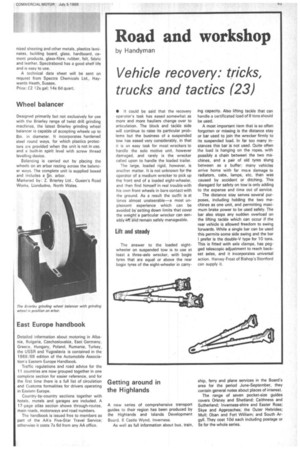Road and workshop
Page 65

If you've noticed an error in this article please click here to report it so we can fix it.
by Handyman
Vehicle recovery: tricks, trucks and tactics (23)
• It could be said that the recovery operator's task has eased somewhat as more and more hauliers change over to articulation. The block and tackle side will continue to raise its particular problems but the business of a suspended tow has eased very considerably, in that it is an easy task for most wreckers to handle the solo motive unit, however damaged, and rarely is the wrecker called upon to handle the loaded trailer.
The large, loaded rigid, however, is another matter. It is not unknown for the operator of a medium wrecker to pick up the front end of a loaded eight-wheeler, and then find himself in real trouble with his own front wheels in bare contact with the ground. As a result the outfit is at times almost unsteerable—a most unpleasant experience which can be avoided by' settingdown limits that cover the weight 'a particular wrecker can sensibly lift-and remain safely manageable.
Lift and steady
The answer to the loaded eightwheeler on suspended tow is to use at least a three-axle wrecker, with bogie tyres that are equal or above the rear bogie tyres of the eight-wheeler in carry
ing capacity. Also lifting tackle that can handle a certificated load of 8 tons should be used.
A most important item that is so often forgotten or missing is the distance stay or bar used to join the wrecker firmly to its suspended load. In far too many instances this bar is not used. Quite often the load is hanging on the ropes, with possibly a chain between the two machines, and a pair of old tyres slung between as a buffer: many vehicles arrive home with far mo.-e damage to radiators, cabs, lamps, etc, than was caused by accident or ditching. This disregard for safety on tow is only adding to the expense and time out of service.
The distance stay serves several purposes, including holding the two machines as one unit, and permitting maximum brake power to be used safely. The bar also stops any sudden overload on the lifting tackle which can occur if the rear vehicle is allowed freedom to swing forwards. While a single bar can be used this permits some side swing and the bar
prefer is the double-V type for 10 tons. This is fitted with axle clamps, has pegged telescopic adjustment to reach backset axles, and it incorporates universal action. Harvey-Frost of Bishop's Stortford can supply it.
























































































































































